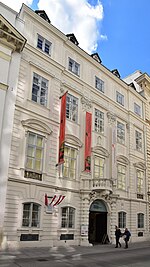Ballhausplatz

Ballhausplatz is a square in central Vienna containing the building (with the address Ballhausplatz 2) that for over two hundred years has been the official residence of the most senior Austrian Cabinet Minister, the State Chancellor, today the Chancellor of Austria (Prime Minister). As a result, Ballhausplatz is often used as shorthand for the Austrian Federal Chancellery. Until 1918 the Foreign Ministry of Austria-Hungary was also housed here. Similar to Downing Street or the Hotel Matignon, the word Ballhausplatz (or Ballplatz for short) is a synecdoche for the seat of power. Ballhausplatz is located in the first district Innere Stadt in central Vienna, a few minutes' walk from the Austrian Parliament Building and on the edge of the grounds of Hofburg Imperial Palace. Until 1754 the square itself did not exist, as an imperial hospital was located there. Ferdinand I, Holy Roman Emperor, erected a real tennis house there, the Ballhaus (ball house). Later the building was used for the Imperial Court Construction Office (Hofbauamt). At the end of the 18th century the Ballhaus was ripped down.
Excerpt from the Wikipedia article Ballhausplatz (License: CC BY-SA 3.0, Authors, Images).Ballhausplatz
Ballhausplatz, Vienna Innere Stadt
Geographical coordinates (GPS) Address Nearby Places Show on map
Geographical coordinates (GPS)
| Latitude | Longitude |
|---|---|
| N 48.208 ° | E 16.364 ° |
Address
Amalienburg
Ballhausplatz
1010 Vienna, Innere Stadt
Austria
Open on Google Maps










